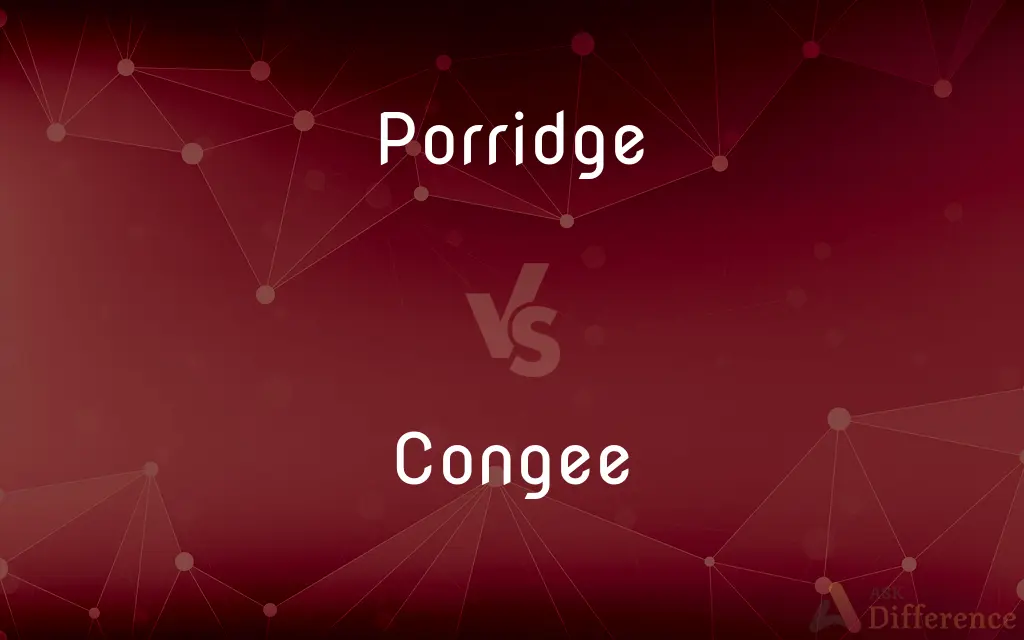Porridge vs. Congee — What's the Difference?
By Tayyaba Rehman & Fiza Rafique — Updated on September 9, 2023
Porridge is a hot cereal dish made by boiling grains, legumes, or even some vegetables in milk or water. Congee is a type of rice porridge that is often much thinner and is commonly eaten in Asian countries.

Difference Between Porridge and Congee
Table of Contents
ADVERTISEMENT
Key Differences
Porridge is a term broadly applied to hot cereal-like dishes made by boiling a variety of grains, legumes, or sometimes even vegetables in water, milk, or a combination of both. Congee, on the other hand, is specifically a rice porridge, typically prepared by simmering rice in a large amount of water or broth. While porridge can be made from oats, cornmeal, barley, or other grains, congee is exclusively made of rice.
In terms of consistency, porridges can be thick or thin based on preference and the grain used. Congee is usually on the thinner side, often resembling a watery gruel. Porridge can be either sweet or savory, flavored with elements like sugar, fruits, or spices. Congee, conversely, is often seasoned with savory items such as meats, century eggs, or pickled vegetables.
Regarding cultural significance, porridge is a staple in many Western and African countries. Congee is a common dish in various Asian cultures, often served as a breakfast item or a dish consumed when one is ill. Both porridge and congee can carry sentimental value, often associated with home cooking and comfort food.
In the culinary world, porridge has seen gourmet adaptations with exotic grains and flavor profiles. Congee also has its upscale versions, often featuring luxury ingredients like abalone or scallops. Whether it's porridge or congee, both dishes can range from humble home-cooked meals to fine-dining experiences.
Comparison Chart
Base Ingredient
Various grains and legumes
Rice only
ADVERTISEMENT
Consistency
Can be thick or thin
Generally thinner
Flavoring
Sweet or savory
Usually savory
Cultural Origin
Western and African
Asian
Common Uses
Breakfast, any meal
Breakfast, medicinal
Compare with Definitions
Porridge
A hot dish made by boiling grains in water or milk.
She made oatmeal porridge for breakfast.
Congee
A rice porridge commonly eaten in Asian countries.
Congee is her go-to meal when she's sick.
Porridge
A boiled grain dish, sometimes savory, used as a meal base.
Cornmeal porridge goes well with stew.
Congee
A watery rice dish seasoned with meats or vegetables.
He added shredded chicken to his congee.
Porridge
A hot cereal dish often sweetened with fruits or sugar.
His favorite porridge includes cinnamon and apple slices.
Congee
A thin, boiled rice dish often consumed for its soothing properties.
Congee is often given to babies and the elderly.
Porridge
A comfort food often made with oats and flavored to taste.
Her homemade porridge is the best remedy for a cold day.
Congee
A rice-based gruel frequently flavored with pickled vegetables or meats.
Century egg congee is a traditional dish.
Porridge
A versatile hot food made by simmering grains or legumes.
You can make porridge out of barley, oats, or even lentils.
Congee
An Asian staple food made by simmering rice in a large amount of water.
A bowl of congee makes for a simple, satisfying meal.
Porridge
Porridge is a food commonly eaten as a breakfast cereal dish, made by boiling ground, crushed or chopped starchy plants—typically grain—in milk. It is often cooked or served with added flavourings such as sugar, honey, (dried) fruit or syrup to make a sweet cereal, or it can be mixed with spices, meat or vegetables to make a savoury dish.
Congee
Congee or conjee ( KON-jee) is a type of rice porridge or gruel eaten in Asian countries. The word 'congee' itself is a derivation of the Tamil word கஞ்சி (kanji, IPA: [ˈkaɲdʑiː]).
Porridge
A dish consisting of oatmeal or another meal or cereal boiled in water or milk.
Congee
Variant of congé.
Porridge
Time spent in prison
I'm sweating it out doing porridge
Congee
A traditional Asian rice porridge.
Porridge
A soft food made by boiling oatmeal or another meal in water or milk.
Congee
Formal or authoritative permission to depart.
Porridge
A dish made of grain or legumes, milk and/or water, heated and stirred until thick and typically eaten for breakfast.
Eat your porridge while it's hot!
Congee
An abrupt dismissal.
Porridge
Oatmeal porridge.
Congee
A leave-taking.
Porridge
Rice porridge; congee.
Congee
A formal bow.
Porridge
A prison sentence.
Just do your porridge and keep your head down.
Congee
(Architecture) A concave molding.
Porridge
(rare) A type of thick soup or stew, especially thickened with barley.
Congee
Leave, formal permission for some action, :
Porridge
A food made by boiling some leguminous or farinaceous substance, or the meal of it, in water or in milk, making of broth or thin pudding; as, barley porridge, milk porridge, bean porridge, etc.
Congee
(obsolete) Formal permission to leave; a passport.
Porridge
Soft food made by boiling oatmeal or other meal or legumes in water or milk until thick
Congee
(obsolete) Formal dismissal; (figurative) any dismissal; originally & particularly humorously ironic abrupt dismissal without ceremony.
Congee
(obsolete) Formal leavetaking; (figurative) any farewell.
Congee
A fee paid to make another go away, (particularly) alms to a persistent beggar.
Congee
(archaic) A bow, curtsey, or other gesture (originally) made at departure but (later) including at greeting or in obeissance or respect.
Congee
A type of thick rice porridge or soup, sometimes prepared with vegetables and/or meat.
Congee
(archaic) To give congee, particularly
Congee
To give formal permission to leave; to dismiss.
Congee
To give formal permission to do something; to license.
Congee
(archaic) To take congee: to leave ceremoniously.
Congee
(archaic) To make a congee: to bow, curtsey, etc., while leaving; (figuratively) to make obeissance, show respect, or defer to someone or something.
Congee
See Congé, Conge.
And unto her his congee came to take.
Congee
Boiled rice; rice gruel.
Congee
A jail; a lockup.
Congee
A Chinese rice gruel eaten for breakfast
Congee
Depart after obtaining formal permission;
He has congeed with the King
Congee
Perform a ceremonious bow
Common Curiosities
Is Congee always made from rice?
Yes, congee is specifically a rice porridge.
Where is Porridge commonly eaten?
Porridge is commonly eaten in Western and African countries.
What is Porridge?
Porridge is a hot dish made by boiling grains, legumes, or vegetables in water or milk.
What is Congee?
Congee is a type of rice porridge commonly consumed in Asian countries.
Is Congee thick or thin?
Congee is generally on the thinner side, resembling a watery gruel.
Can Porridge be sweet or savory?
Yes, porridge can be either sweet or savory depending on added flavors.
Is Congee usually sweet or savory?
Congee is usually savory, often seasoned with meats or pickled vegetables.
Is Porridge considered a comfort food?
Yes, porridge is often considered a comfort food.
Is Porridge always made from oats?
No, porridge can be made from various grains and legumes.
Is Porridge usually thick or thin?
Porridge can vary in consistency from thick to thin depending on the grain and preference.
Is Congee mainly a breakfast dish?
Congee is often eaten for breakfast but can also be consumed at other times.
Can both Porridge and Congee be gourmet dishes?
Yes, both porridge and congee can be elevated to gourmet dishes with exotic grains or luxury ingredients.
Where is Congee commonly eaten?
Congee is commonly eaten in various Asian countries.
Is Congee considered a comfort food?
Yes, congee is often consumed as a comfort food, especially when one is ill.
Can Porridge be eaten at any meal?
Yes, porridge can be eaten at any meal, though it's commonly a breakfast dish.
Share Your Discovery

Previous Comparison
Domaine vs. Watch
Next Comparison
Happy vs. ExcitedAuthor Spotlight
Written by
Tayyaba RehmanTayyaba Rehman is a distinguished writer, currently serving as a primary contributor to askdifference.com. As a researcher in semantics and etymology, Tayyaba's passion for the complexity of languages and their distinctions has found a perfect home on the platform. Tayyaba delves into the intricacies of language, distinguishing between commonly confused words and phrases, thereby providing clarity for readers worldwide.
Co-written by
Fiza RafiqueFiza Rafique is a skilled content writer at AskDifference.com, where she meticulously refines and enhances written pieces. Drawing from her vast editorial expertise, Fiza ensures clarity, accuracy, and precision in every article. Passionate about language, she continually seeks to elevate the quality of content for readers worldwide.















































